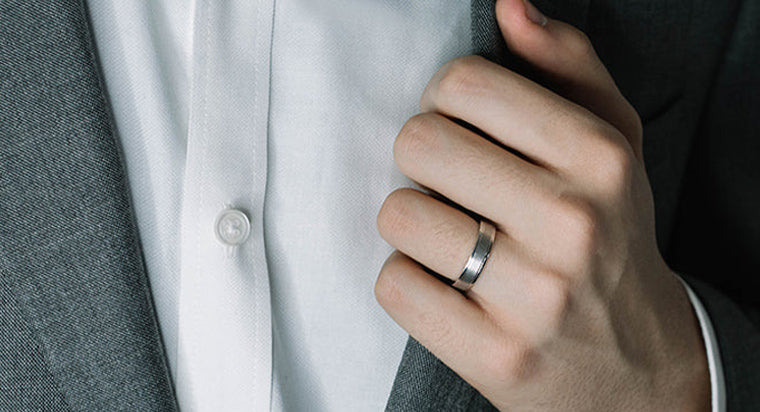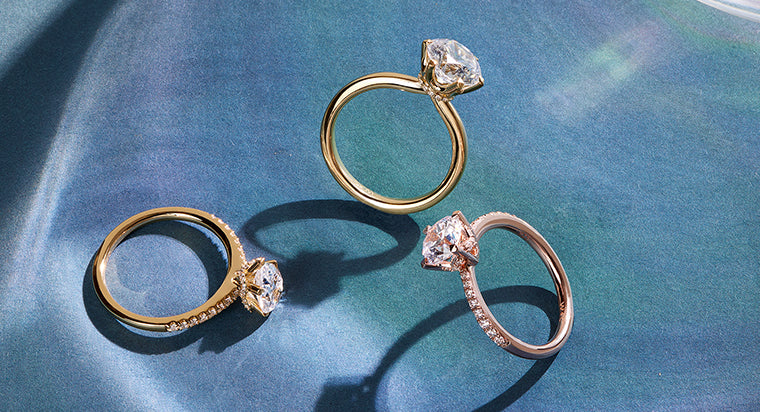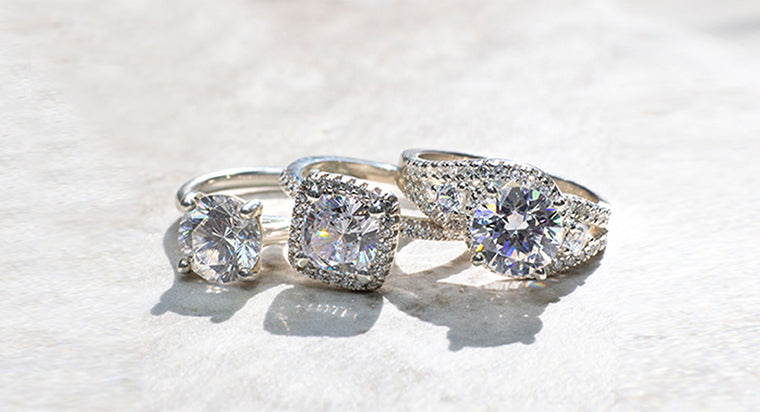Platinum Ring & Jewelry Guide

TABLE OF CONTENTS
Platinum
Platinum is a rare metal, that is 25 times harder to find than gold. It is more expensive than gold and has been found in only a few locations around the world. Platinum is a strong, durable metal and highly regarded when crafting jewelry. It’s gleaming, silvery white sheen pairs beautifully with all gemstones and diamonds. This is a metal of choice when crafting jewelry that will be worn for years to come.
Origin of Platinum
Platinum was first used as early as 1200 BC, in ancient Egyptian tombs. Traces of platinum were found in the gold, however, it is unclear whether or not the Egyptians knew that platinum was even in their gold.
After that, the first time that platinum was referenced in European history was in 1557, in the writings of Julius Caesar Scaliger. He described it as an unknown metal “which no fire nor any Spanish artifice has yet been able to liquefy.” The Spanish people originally viewed platinum as an impurity to gold, so it was just thrown away and not valued at all. There was even a law that forbade gold to be used with platinum because it would make it impure.
Platinum first began to be scientifically studied in 1748, by Antonio de Ulloa. He studied it in a mineralogy lab in Spain. Many other chemists began to study platinum not too long after.
In 1752, a man named Henrik Scheffer published a scientific report of platinum. In this report, he called platinum “white gold,” which no one had ever done before. He wrote that even though platinum isn't as pliable as gold, it has virtually the same resistance to corrosion.
The majority of platinum is mined in South Africa with the balance found in North America, South America and Russia.
Platinum jewelry is crafted with 950 grade pure platinum. Because of it's natural durability and white shine, platinum does not require rhodium plating. Platinum jewelry is crafted with 95% pure platinum mixed with an alloy of 5% iridium to offer strength. Because platinum already has a beautiful silvery luster, it does not need to be rhodium plated and therefore requires less maintenance. Platinum is a malleable metal, meaning that it can be shaped into a myriad of intricate but strong jewelry designs. It is one of the most dense metals, which is a contributing factor in its strength. Platinum is also hypoallergenic, meaning that anyone with even sensitive skin or allergies to other metals can wear it with ease. Platinum also weighs more than gold and can be a good choice for those who want a sturdy metal option. It is resistant to corrosion and tarnishing, which makes it the perfect choice for daily wear. Over the course of wear, platinum can get scratched creating a satin-like sheen on the surface of the metal. For those that do not prefer this slightly duller look, the scratches can easily be removed with a cleaning and polishing.
To maintain the beauty of your platinum jewelry, simply use mild non-abrasive soap and warm water to lift away dirt and grease on your jewelry. Use a soft-bristled brush to reach areas like underneath prongs or in between grooves. Periodically, send you jewelry to With Clarity for a professional ultrasonic cleaning and repolishing. This will ensure that the jewelry stays brilliant for a lifetime.
Remember to remove your platinum jewelry when doing heavy or strenuous work, using harsh cleaning solutions of chemicals or entering chlorinated pools or hot tubs. Harsh chemicals and hard impact can damage the metal over time.
Platinum vs Other Metals

Apart from platinum, here is a list of popular metals that we will compare and contrast to platinum:
Platinum Vs. Silver
Silver is softer than platinum, which also makes it less durable. Platinum is used instead of silver in many engagement rings because it will last longer.
Platinum Vs. Yellow Gold
There is a distinct color difference between platinum and yellow gold. Yellow gold is softer than platinum, making it more prone to scratching and bending. Platinum is more durable than yellow gold, making it a popular choice for engagement rings that will be worn every day. Yellow gold is great for pieces of jewelry that you won't wear as often. Colorless diamonds topically always look better in platinum metal settings compared to yellow gold ones. This is because yellow gold causes diamonds to have a slightly yellow tinge. The only instance where yellow gold would be a better choice for diamonds is if they are lower quality and have a lower color grade, because the yellow gold of the metal could mask the impurities of the diamond. Platinum is the best choice if you want to show off a brilliant ring.
Platinum Vs. Tungsten
Tungsten has a very similar color to platinum. Tungsten can be more appealing to some people because it is more affordable. Platinum is also more prone to scratching than Tungsten is.
The main issue with Tungsten is that it's very difficult to cut into. This means that if you need to get a ring re-sized, it will be much more difficult to do (not to mention more expensive) than if you had a platinum ring.
Another downside of Tungsten is that unless you are using a laser, it can't be engraved. Platinum, on the other hand, can certainly be engraved.
Platinum Vs. Titanium
These two metals look very similar to each other. They are also both hypo-allergenic. Titanium is cheaper than platinum. Titanium is also more durable than platinum is, and it gets scratched less often. However, once it does get scratched, it is way harder to remove or polish compared to if the scratch had been on platinum. Similar to Tungsten, Titanium rings are extremely difficult to get resized.
Platinum Vs. Palladium
Palladium has a color that resembles platinum. It is also very similar in terms of durability. Both platinum and palladium are great for those with sensitive skin because they are hypo-allergenic. Palladium is appealing to some because it's cheaper than platinum, and it also weighs less than platinum does.
Benefits of Platinum Engagement or Wedding Rings
There are three main benefits that come with choosing platinum as a metal choice for your engagement or wedding rings. They are:
Purity
Platinum is a very pure metal compared to most. It is typically between 95-99% pure, which is a very high rating.
Hypoallergenic Properties
This ties in with platinum's purity. Due to how pure it is, it can be worn by people who have sensitive skin, without causing them any allergic reactions. Yellow gold, on the other hand, can often cause skin irritation because it contains nickel. Platinum will not cause any skin irritation or rashes.
Durability
Platinum is by far one of the most durable metals that can be used for jewelry. Platinum will last you much longer, especially compared to something such as yellow gold. Even after years of use, it won’t show any signs of wear. This also means that platinum won't need to be fixed as much as other metals might, and it has less of a chance of breaking or scratching.
FAQs
When was platinum first used?
Platinum was first used as early as 1200 BC in ancient Egyptian tombs, where traces of platinum were found in gold. It is currently mined in Canada, South Africa, America, Australia, and Russia.
What are the advantages of platinum jewelry?
Platinum jewelry is made with pure 95% pure platinum and 5% iridium making it extremely durable and fit for regular wear. It has a natural white shine with a patina finish that does not require re-plating or extra maintenance. Its malleable nature allows it to be shaped into intricate, beautiful jewelry designs, so you can choose from a variety of options. Also, it is hypoallergenic, making it ideal for people with sensitive skin.
How to clean platinum jewelry?
You can clean your platinum jewelry with a mild non-abrasive soap and warm water solution to remove dirt and grease. Then, use a soft-bristled brush to reach areas underneath prongs or between grooves. Periodically, you should send your jewelry to a professional for ultrasonic cleaning and re-polishing to ensure that your jewelry stays brilliant for a lifetime.
What is the difference between a platinum engagement ring and a silver engagement ring?
Silver is soft, making an engagement ring of this metal less durable. A platinum engagement ring will be a better choice because not only is it hypoallergenic, but it is also sturdy, durable, and corrosion-free.









